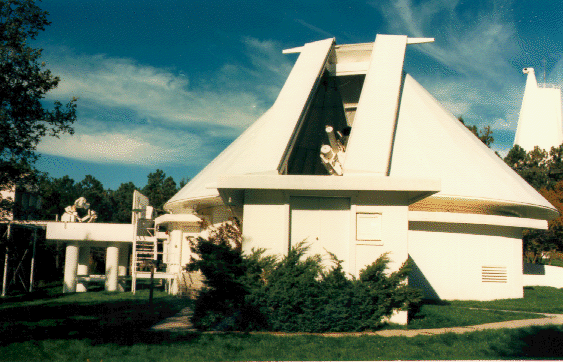
Peter G's Eclipse Chasing Page


|
Peter G's Eclipse Chasing Page |

|
Hi there, my name is Peter and I spend much of my time running around the world chasing total solar eclipses! When I'm not carrying large boxes of equipment from one country to another I work at The Queen's University of Belfast in Northern Ireland.

These pictures show what are called BAILY'S BEADS at the end of a total eclipse of the Sun. Baily's Beads are actually caused by rays of light from the Sun's surface ( photosphere) shining along crevices on the edge of the Moon.
Copyright Fred Espenak, NASA.
|
Well, on Fridays I usually hang up my telescope for the weekend and spend most of Saturday and Sunday jumping out of airplanes! So far I've only jumped out at 3,500 feet but I hope to be sky diving from 10,000 feet by the end of the year! Copyright Peter Gallagher & The Queen's University of Belfast Parachute Club |

|
When not falling through the sky at hundreds of miles per hour I spend a lot of time trying to work out why the corona is so hot - the temperature is almost 2,000,000 C! This problem has puzzled astronomers for more than 50 years and people have lots of different ideas about it. I believe that the corona is mainly heated by massive waves travelling up from the photosphere (the Sun's surface) and dumping all their energy into the corona to heat it up.
It's a bit like what you see at the seaside but at the energies involved are millions of times smaller than on the Sun. At the seashore the waves travel on the surface of the sea and lose their energy by crashing into the beach. They don't heat it up much. Instead they move large boulders and can make cliffs collapse. On the Sun, waves carry large amounts of energy into the corona, which cause small, periodic brightenings - these are the little beasties I work on!

|
To look for these waves I've had to travel to the Sacramento Mountains in the middle of the New Mexico desert to use some of the largest solar telescopes in the world. Solar astronomers use a special type of telescope to look at the Sun which is called a coronagraph. A coronagraph simply blocks out the light from the surface of the Sun so that we can see the faint atmosphere of the Sun which we call the corona.
|
Copyright Peter Gallagher |
It's very difficult to see the corona because the visible light from the solar surface is a million time brighter than the light from the corona. The coronagraph is a very carefully designed instrument which allows us to simulate a total eclipse of the Sun all the time, so long as the Sun is shining, of course.

WHERE WILL THE AUGUST 11TH 1999 ECLIPSE BE VISIBLE?
WHAT ELSE CAN YOU SEE DURING AN ECLIPSE?


|